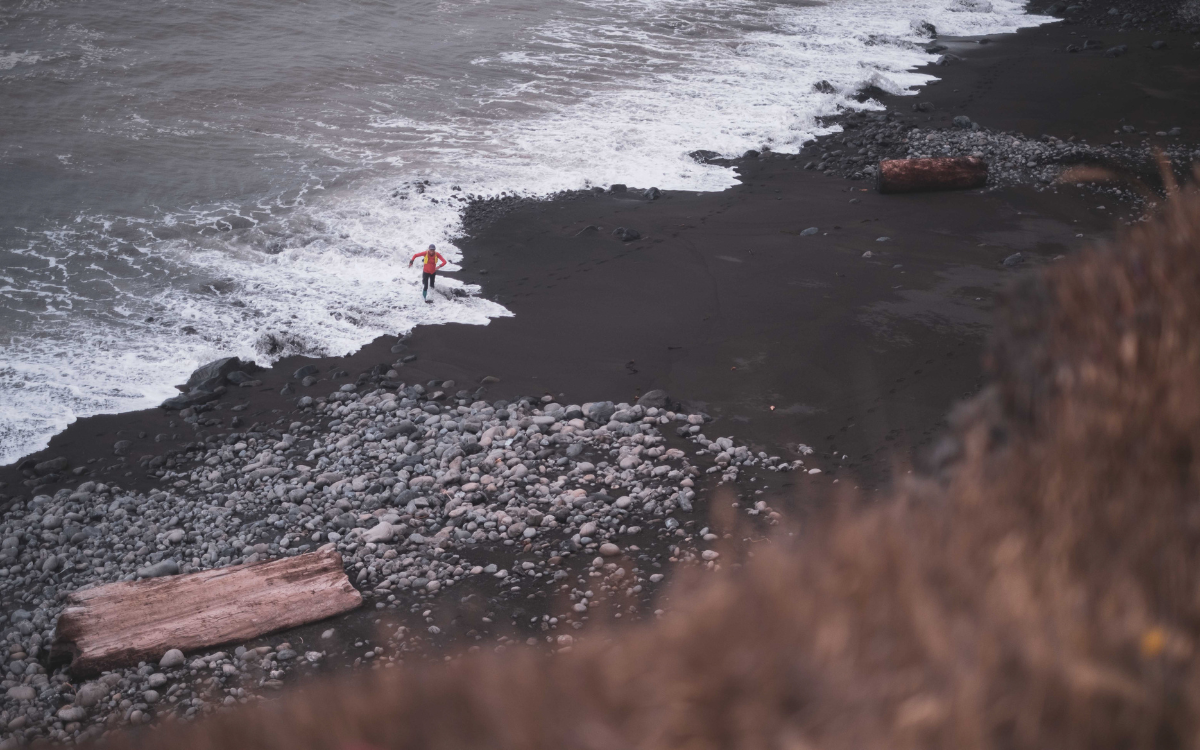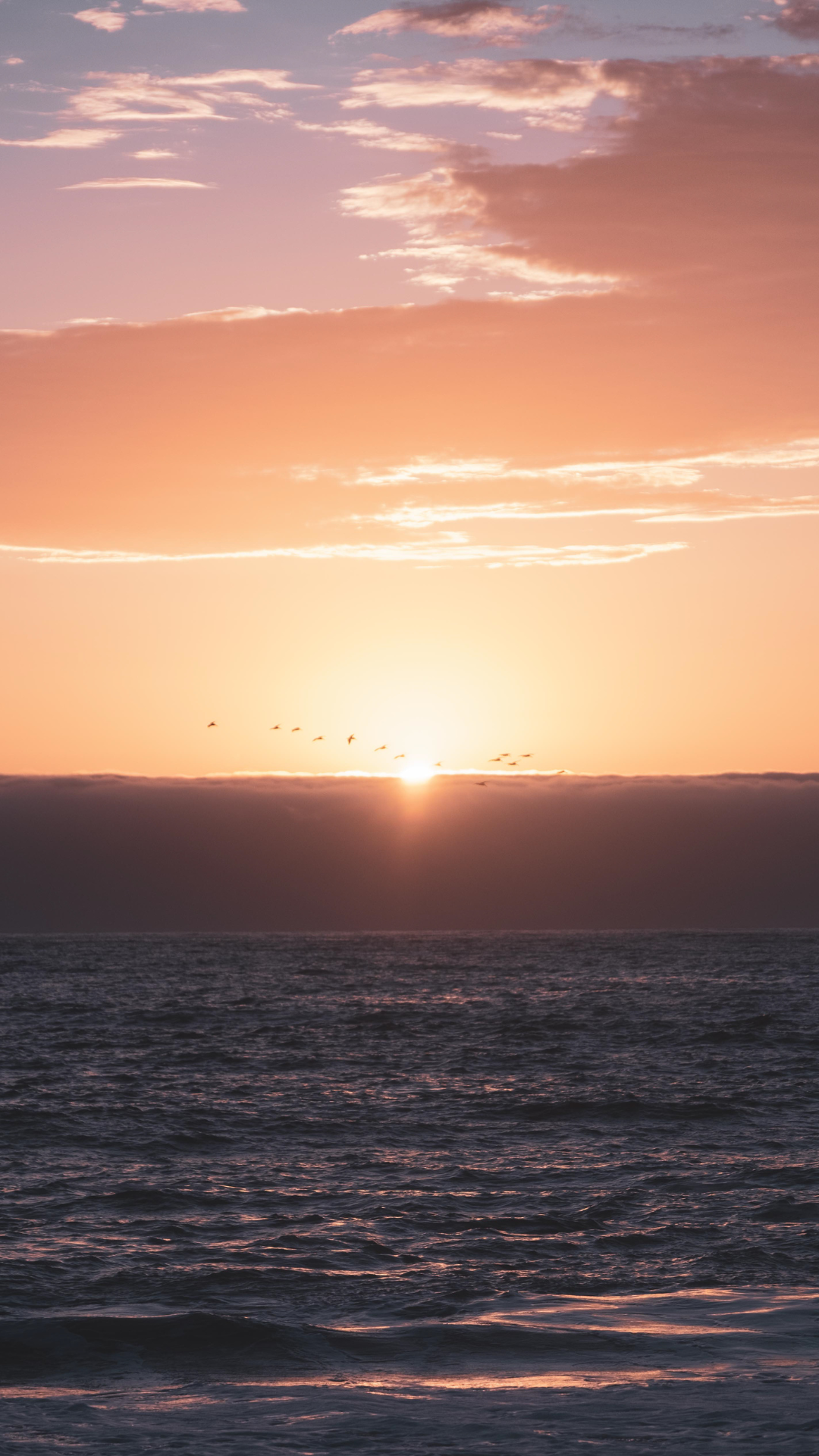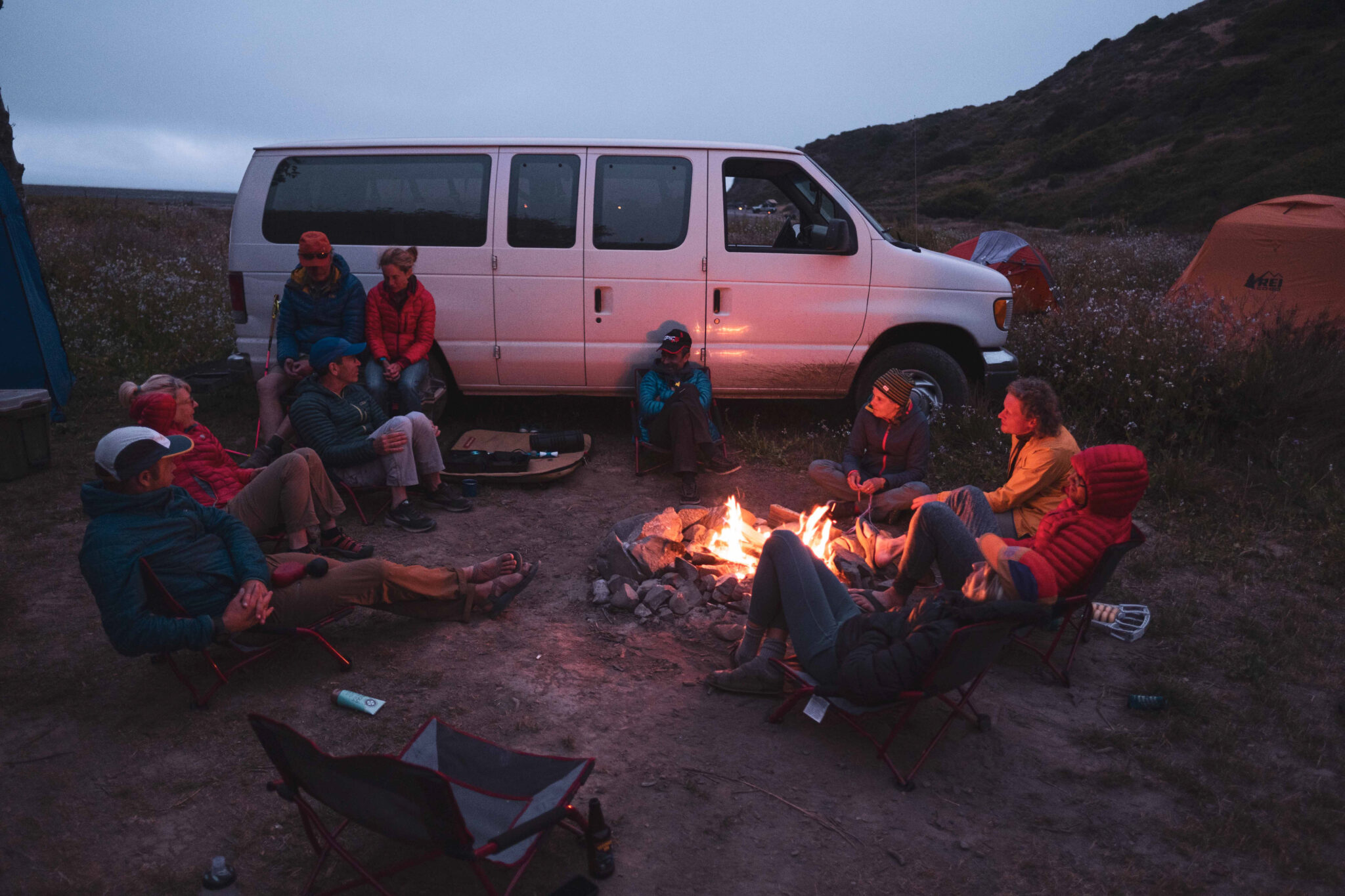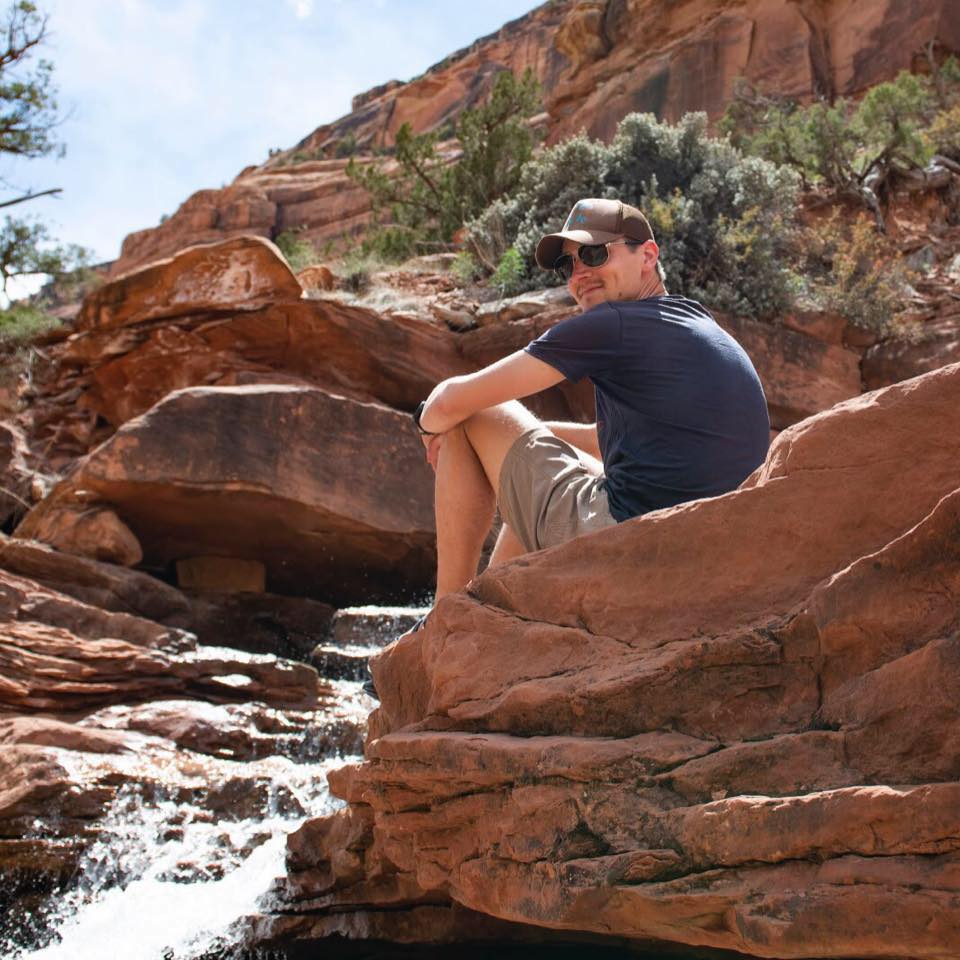Adventures in Risk Management on the Lost Coast Trail
Risk management is a cornerstone of Aspire operations. Each trip’s unique variables call for a different approach to keeping runners safe and ensuring an enjoyable experience. Even so, when running through wilderness environments, nature makes the final call. Our “Expecting the Unexpected” series recounts times when things didn’t go according to plan, and the unique opportunities for bonding and adventure those moments create when risk is managed well.
There’s a mercantile in Leggett, CA, (population 56) that serves as a meet-up point and final outpost for adventurers heading off the grid and into the remote coastal wilderness. The shop offers basic provisions like you’d expect. It also sells a green-brimmed hat with a punchy message about the picturesque and famously twisted route nearby: “I survived Highway 1.”
A more accurate hat might say: “I survived Aspire’s Lost Coast Trail Run.”

It’s a given that things go wrong on long-distance backcountry excursions. Runners might like to focus on physical strength and race tactics. But problem-solving is the core of ultrarunning and outdoor adventuring. With the right mindset, risk management plan and a bit of luck, getting out of that tough time is also the root of the story everyone shares at the end-of-trip campfire.
At least that’s how it went on Aspire’s unforgettable June trip along the Lost Coast.

A three-hour’s drive north of San Francisco, this remote and wild slice of the King Range National Conservation Area and Sinkyone Wilderness feels more like a scene out of Jurassic Park than a protected patch of land in the most populous U.S. state.
Cell signal? Forget about it. Roads? Hope you don’t get car sick, don’t have to pass anyone, and have an hour or three to get where you’re going. People? Mostly just backpackers doing a sandy 25-mile beach trek in several days — a section Aspire runners will be covering on Day 1. And then there’s the thistle-berry-poison-oak bushwhack interspersed along the 60-mile route.

The 19th century Gold Rush brought death and disease to the indigenous Sinkyone people here. Then, timber harvesting and oil drilling carved up the land and left behind sawed-off redwood stumps and squiggly roads that seemingly go to nowhere. When the oil boom dried up in the 1930s, people left the region in droves, giving it the apt name. But by hour five on a trail here, it’s reasonable to think that the bluffs just don’t want to be found.
If things have to go sideways in such remote places, one hopes it’ll be something relatively minor. An irked knee after a 25-mile day on a slanted sand beach, perhaps, or a bent tent pole while rushing to pack up camp in the pouring rain. They’re the kind of things that in the moment can — and do — feel crushing. Managed with a well-stocked tool kit and a bit of know-how and they just become part of the experience.
Where the real strength shines is when something bigger happens, when things really start to go off-script, and when a group is tested in bigger, more complicated ways.
Welcome to Day 1.
The Lost Coast run begins with a near-marathon-length run through deep sand, slick rocks and precarious bluffs spanning Mattole River Campground to Shelter Cove. The route has three tide-dependent crossings that runners must traverse before a certain time or else risk being cut off from the trail until the water recedes. The longest crossing, the Rattlesnake High Tide Zone, is a 3-mile stretch that, on this particular trip, runners needed to be through by about 4:30 p.m.
It would be a push for everyone.
For the six who didn’t make it in time, it’d be the setting for a story that would dominate the trip.
An Aspire guide bringing up the back of the pack realized by about 3:30 p.m. that they were up against the clock and unlikely to make it through the tide zone in time. With waves inching higher, the group needed a backup plan. So they made one.

One runner scouted ahead for a possible bailout route that was loosely sketched out on a map, a creek and possible trail that climbed toward the hills. Meanwhile, the guide bounded between runners and ensured everyone knew the plan — or, more to the point, knew that there was a solid plan to begin with.
Before long, they’d made the turnoff, climbed above the water and hunkered down next to now-infamous Buck Creek. That’s where the problem-solving really began.

Realizing they would be out for at least twice as long as they had anticipated when they started running that morning, everyone emptied their running packs to share food. They inventoried supplies as it became clear they’d be bivvying on the bluff deep into the night. “What happens at Buck Creek stays at Buck Creek,” they’d say over and over, huddled in gold-colored emergency blankets as the sun dropped below the Pacific and turned the sky a stunning shade of orange.
Unplanned and worrisome as it was at the time, it certainly could have been worse.
Aspire guides and many clients travel with Garmin inReach devices, which allow for some communication while in the field. By mid-afternoon on, the team shuttling camp toward Shelter Cove knew that nearly half the runners were taking an impromptu trek inland. So they made plans to meet runners who made the crossing in time and prepped backup plans for those who hadn’t. Even when things were uncertain and when communication became spotty, the situation never spiraled. It was one decision after another.
At one point that night, a guide loaded a van with food, water and beer and headed toward the beach group’s bail-out route in the event they abandoned the beach. The plan to meet them midway down the path was ultimately scrapped after the beach group decided to smartly wait out the tide and resume their beach trek at midnight.
Alongside fresh bear prints, and with a renewed motivation to finish, the group pushed the pace and arrived at a twinkle-lit Sprinter van at 2 a.m. Hot food and beer awaited them, as did dry clothes, pitched tents and rolled-out sleeping pads back at camp.
Situations like these are rare. They’re also where staying level-headed and thinking through decisions pays dividends, knowing that with proper risk management, it’s all-but-guaranteed everyone will stay safe and walk away with a story to tell. By breakfast some six hours later, the beach group was regaling everyone with stories of what happened, who stepped up and how well — all things considered — the night ended up going. Despite the lack of sleep, the beach group rallied and hit the trail for an abbreviated Day 2 trek. Everyone’s reward? Hammocks, lounge chairs, burgers and sunset over the Pacific, albeit this time from the comforts of a wooden camp bunkhouse alongside easy-going conversation and a bowl of dutch-oven-baked apple crisp.

The first day set the tone for the rest of the trip, both in terms of things going wrong and finding solutions. Multiple runners’ water filters broke, so people worked together to share. On Day 3, when most of the beach group decided against making the 20-mile run/bushwhack to round out the trip, some pitched in on helping a guide navigate the harrowing narrow roads. Once everyone arrived at Usal Beach, the party at camp — complete with margaritas around the fire — lasted late into the night, up until a few raindrops began to fall…

Raindrops turned to a downpour overnight. Bags and bodies were sopping wet by the time everyone piled into the vans to leave that final morning. But the rain had turned the campsite to tacky soup that swallowed Aspire’s loaded Sprinter van tire.
For a moment, anxiety swept the group. Some people had flights to catch later that morning. Most everyone had “real lives” to return to. But the van went nowhere, even with a dozen runners attempting to shove the van forward. So much for Plan A.
Plan B: Surely one of the 4×4 crews camped a half-mile away at the beach had some traction skids they could loan out. But one by one, the gruff beach campers told a guide that they didn’t have skids and hadn’t seen anybody with them, either. Despair deepened.
On to Plan C: Build an improvised skid, replete with rocks that both guides and clients had scooped up from camp and smashed together into an improvised backcountry traction device. Some looked on skeptically. Others made the kind of nervous laugh someone makes when they know something will make a hilarious story someday when they’re dry and not off the grid hanging around camp in a downpour with a stuck van.
One more hope-filled push from everyone and the Sprinter lurched forward and fishtailed through camp toward the hard-packed road.
Cheers. Claps. Problem solved.
Then gasps.

Exactly what happened before the Sprinter made it to that road will make for a helluva story on problem solving, that is, after the body shop gets a look at the dented side and damaged door, courtesy of a leaning tree.
At the Leggett mercantile where a group of strangers had met several days earlier, now everyone high-fived, hugged and swapped phone numbers after an unforgettable trip on the Lost Coast.
The views and stories will no doubt outlive any “I survived” hat.
There is talk, though, of making a t-shirt about what happened up Buck Creek…
Run the Lost Coast Trail Stage with Aspire.
2023 Registration opens November 1st, 2022.

Jason Pohl, 32, raced road marathons for a decade while also bagging peaks in Colorado’s high country and taking backpacking trips throughout the West. He ran the Boston Marathon twice and in 2012, largely on a whim, did a self-supported bicycle tour from Washington to Maine. He’s now all-in on trail running with a handful of 100k finishes in the books and a string of self-supported adventures on the horizon. He works in the “real world” as an investigative journalist in Sacramento, California, where he lives with his partner, Mel.

